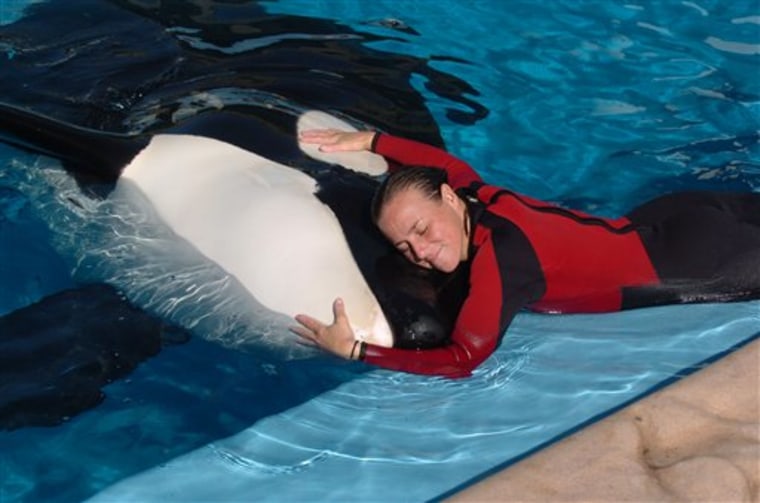Shamu is big business at SeaWorld, which owns more killer whales than anyone else in the world and builds the orca image into its multimillion-dollar brand, and the killing of a trainer this week won't change that.
Shamu shows will resume Saturday, three days after a six-ton bull orca dragged Dawn Brancheau underwater to her death at the end of a show in Orlando, SeaWorld Parks and Entertainment President Jim Atchison said Friday.
But staff at the for-profit parks in Orlando, San Antonio and San Diego won't get back in the water with the hulking ocean predators until SeaWorld and a panel of outside experts complete a top-to-bottom review of how the company handles orcas.
"We have created an extraordinary opportunity for people to get an up-close, personal experience and be inspired and connect with marine life in a way they cannot do anywhere else in the world," Atchison said as orcas swam behind him on the other side of an underwater window, "and for that we will make no apologies."
The timing of the killer whales' return to performances reflects just what the sleek black-and-white mammals mean to SeaWorld, which the private equity firm The Blackstone Group bought last fall for around $2.7 billion from Anheuser-Busch InBev in a deal that included two Busch Gardens theme parks and several other attractions.
"SeaWorld operations are built around Shamu and the orca. So quantitatively they mean literally hundreds of millions of dollars to that company," said Dennis Speigel, president of International Theme Park Services, a consulting firm.
A valuable animal
No animal is more valuable to that operation than Tilikum, the largest orca in captivity, which now has been involved in the deaths of two trainers and requires a special set of handling rules, which Atchison wouldn't specify. Captured nearly 30 years ago off Iceland, Tilikum has grown into the alpha male of captive killer whales, his value as a stud impossible to pin down.
Killer whales — actually part of the porpoise family — aren't endangered; estimates of their worldwide population range from 50,000 to more than 100,000.
But it is illegal to capture killer whales in the U.S. and several other countries, and while a few have been caught in recent years in Russia and Japan, U.S. import laws make it difficult to acquire an orca caught in the wild.
"Really, you can't buy them," said Speigel, who put the market value of an individual whale at up to $10 million.
That makes breeding the best way to build a collection of killer whales to draw in visitors at up to $78.95 apiece to sit in the splash zone or take pictures of their kids petting Shamu, the stage name SeaWorld gives all of its adult orcas in shows.
And no one is better at breeding killer whales than SeaWorld.
The company owns 25 of the 42 orcas in captivity, and other theme parks sometimes come to SeaWorld to get theirs.
Tilikum a breeder
At the heart of it all is Tilikum, bought in 1992 from a now-defunct Canadian park where he was one of three orcas that battered and submerged a fallen trainer until she died. After the woman slipped into the water, she became like a plaything to the three whales, said Adam Hellicar, a former diver at Sealand of the Pacific near Victoria, British Columbia.
"They were towing her around by her clothing," said Hellicar, who helped recover the woman's body.
SeaWorld got an emergency permit to buy Tilikum and the other two whales less than a year after that attack, and he became the company's go-to sire. Of the 20 calves born at SeaWorld parks, Tilikum has fathered 13, the company said. SeaWorld has only one other breeding male at the moment.
Before SeaWorld improved its artificial insemination methods, males were more commonly crated, put on planes and lent to various theme parks for breeding, part of the reason that only a handful of parks worldwide have successfully birthed calves. The practice continues despite outcry from animal rights groups.
Keeping a whale is an expensive proposition. When Keiko, the orca that starred in the movie "Free Willy," came to the Oregon Coast Aquarium in the 1990s, it cost $7.8 million to construct his habitat.
Maintaining an aquarium for killer whales can cost $10,000 to $12,000 a month in electric bills, including keeping the water at 50 to 55 degrees.
Some parks have mortality insurance on the animals and can use them as collateral.
Feeding is the cheapest part, requiring about $35,000 a year for roughly 100 pounds of fish a day.
Main attraction
Like many amusement parks, privately held SeaWorld doesn't release attendance figures or say whether it charges other facilities stud fees or other fees for the right to buy or borrow orcas. Nor does it disclose what chunk of its revenue comes from killer whales.
But that's what everyone goes to see.
The Oregon Coast Aquarium saw its largest crowds during the few years that Keiko, the male orca who starred in the movie "Free Willy" lived there in the late 1990s.
"He was a superstar," said Judy Tuttle, curator of marine mammals at the aquarium, who worked extensively with Keiko. "Some people think he's still here. A woman came up to me recently and asked where Keiko was."
Mitchel Kalmanson, a marine mammal appraiser in central Florida who has brokered the sale of two killer whales, agreed that parks such as SeaWorld aren't the same without Shamu.
"Without killer whales, the rest are ancillary shows," he said.
